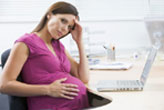|
PT Classroom - Drug-Free Pain Relief During Pregnancy ׀ by Eric Mason, PT, and Emma Mason, LMT |

Eric Mason, PT, graduated from the Manchester Royal Infirmary School of Physiotherapy and Victoria University of Manchester, UK in 1992. He has gained his clinical experience in both the UK and the United States. He is a Florida Licensed Physical Therapist and a member of the American Physical Therapy Association and the Chartered Society of Physiotherapy UK. He worked as a Senior Physiotherapist in Rakehead House, a nationally renowned neurological rehabilitation unit in the UK. He was Director of Physical Therapy for Comprehensive Rehabilitation Services, Inc in Southwest Florida, before moving to Orlando where he developed the Physical Therapy program at the Center for Massage & Clinical Therapy, before opening Physiotherapy Works, LLC in August 2004. He is currently enrolled in the Doctorate program at the University of St. Augustine for Health Sciences. |
|
Drug-Free Pain Relief During Pregnancy Women face a multitude of problems during and after pregnancy, many of which are not only painful but can be detrimental to the health of the mother and the developing fetus. Pharmaceutical relief of these symptoms is often contraindicated, so the physician has to seek safer treatment options. Physical therapy and massage therapy can fill this void.
As the fetus develops and a woman’s ligaments relax in
preparation for childbirth, the pregnant mother undergoes
many postural changes, potentially causing pain. The
increasing size of the uterus causes
the pelvis to tilt anteriorly, and lumbar lordosis
increases. The mother tends to lean back to compensate for
the weight shift, further stretching the linea alba,
increasing thoracic kyphosis and forward head posture,
externally rotating the hips and hyperextending the knees.
Under these conditions, postural muscles are overworked and
ligaments that are already slackened are further stretched.
This can cause pain and biomechanical dysfunction not only
during but also after childbirth.
Headaches are common during pregnancy and usually have a
physical cause. As the breasts and abdomen become heavier,
the mother-to-be often adopts a rounded shoulder posture.
The pectoral fascia and usculature shorten and further
accentuate the kyphotic posture. This in turn causes
cervical protraction and increases the strain on the
cervical extensor muscles. The increased metabolic waste in
the muscles, strain at the muscular insertions to the
occiput and the subsequent positioning of the atlas can all
cause cervical headaches. Physical therapists can use
postural correction exercises, stretches, massage and thoracic mobilization to help improve the
cervicothoracic biomechanics, subsequently decreasing the
headaches.
|
|
|
|
|








